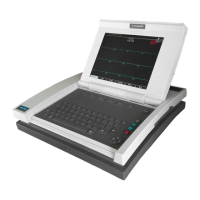Revision B 5-15
CPU Theory of Operation: Theory of Operation
MAC 5000 resting ECG analysis system
2000657-002
Larry
Larry controls the paper drive motor and quantizes the analog inputs.
Since Larry’s code is not field alterable, every motor control parameter
is alterable via BBus. Hopefully this renders the code immune to minor
changes in the printer drive train.
Larry controls the motor speed by delivering a DAC controlled drive
voltage to the motor windings. The 6-bit DAC is implemented using
discrete, binary-weighted resistors directly driven by Larry’s port pins.
The DAC output voltage is compared to a filtered fraction of the applied
DC motor voltage by a comparator. If the motor feedback voltage is
below the DAC voltage, the comparator turns on the motor via an H-
Bridge driver. One motor terminal (which one is a function of motor
direction) is always grounded. The other is alternately driven to either
12V or ground. The duty cycle of the drive signal determines the average
applied voltage and therefore the average motor speed. The feedback
voltage signal is the average of both motor terminals. Since one terminal
is always grounded and the other is driven with a variable duty cycle
between zero and 12V, the feedback signal is positive regardless of
motor direction. An RC filter provides a DC feedback voltage from the
chopped motor drive.
Cue and out-of-paper conditions are sensed via the thermal print head’s
integral optical cue sensor.
Four analog inputs are digitized by Larry:
■ TPH Temperature
■ TPH Dot Resistance
■ External Analog Input #1
■ External Analog Input #2
The sampling rate is indeterminate, but guaranteed to be at least 100Hz.
The external analog inputs are intended to be DC signals from devices
such as ergo bikes or NIBP meters, so no effort is made to synchronize
sampling with the ECG signal. All input signals are low-pass filtered to
avoid aliasing EMI. The external analog input range is 0-10V. Zero volts
produces a code of zero, 10V produces a code of 0xff. The TPH dot
resistance input has a nominal sensitivity of 3.32 Ohms/count. A
nominal print dot (650 Ohms) would produce a reading of 196.
Moe
Moe is responsible for controlling and monitoring the battery, power
supplies, on/off key, system reset and related functions. Moe runs
continuously (on +3V-C), even in the absence of AC power. This
continuous operation is necessary for Moe to accurately monitor the
battery state of charge.
System Startup
When the system is off and the user presses the power key, Moe begins
the startup sequence. If the battery contains sufficient charge, or if AC
power is applied, the mainCPU power supplies (+3V-M and +5V-M) are
enabled and after a suitable stabilization period nSysReset is released.
Moe then keeps tabs on the system via a software watchdog that must

